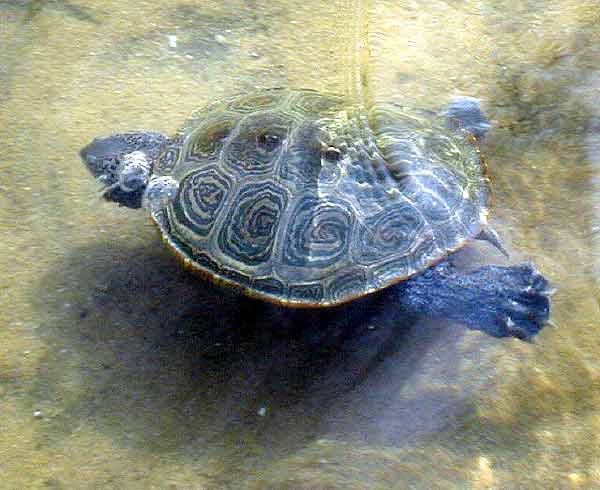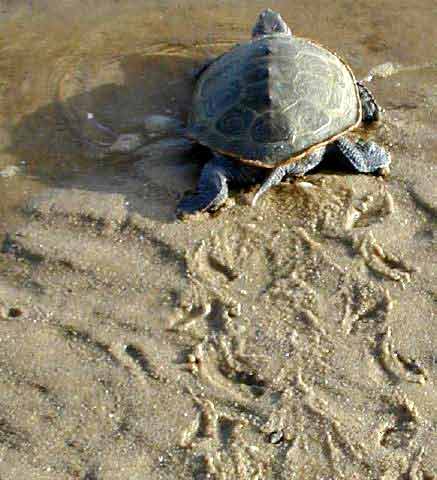Firsts — 23 April 2001
Low tide arrived a little before dawn. The
first “workable” tide of the season. Bathed in salmon, Blackfish Creek
seemed an impressionist’s canvas as I stumbled bleary eyed to the shoreline and
prepared for the morning’s quest. Temperatures hung in the low fifties and
I could feel the swift, cool bay through my waders as I slogged midway across
the channel to reach the rip.

The rip forms as acres of abutting marsh are
drained by Wellfleet’s 15-foot tidal swing and water gushes through the
shrinking “hose” of Blackfish Creek. At the rip itself, water levels drop
to inches when ebb tide approaches and sandbars further constrict the
flow. Diamondback terrapins, surprised to find their habitat disappeared
beneath them, are flushed through the rip with each tidal swing. Last
evening, I saw the first terrapin of the season paddling through the
channel. So, this morning might offer the first capture of the year.

Visibility ranged from good to lousy depending on
location. In the center of the flow, algae and seaweed oozed through the
channel as if it were a giant vacuum cleaner sucking out winter’s
debris. At the edges and in eddies, the water provided enough clarity to
see critters flowing by. The first big carapace I saw wasn’t a turtle but
a large female horseshoe crab that clawed its way onto the rim of the rip and
burrowed down. Further up channel, I saw four mating pairs of horseshoe
crabs, females digging into the soft sand and males hanging on for dear life and
flapping wildly in the turbulent current. A flounder whooshed by me, and
then I caught sight of a mature female (Terrapin 920) zooming out of control,
spinning and tumbling as she bounced over the rip.

Number 920 had last been observed on the morning of 30
August as she basked off a nearby sandbar. At the time she was plump and
ready — at 1400 grams — to handle six months of brumation. Today, she
still seemed in excellent shape, although she had lost 36 grams over
winter. Immediately following her came Terrapin 1046, an eager 7-year-old
male, hot in pursuit and equally out of control in the rapids.

And finally, ten minutes later, a dark colored
mature male (Terrapin 1047) came streaming through the channel.

After getting assessed, measured, weighed, and (for the two males who had
not been previously seen) marked, the threesome hot-footed across the beach and,
with a swish of the tail and a critical hiss, they disappeared once again into depths of
Blackfish Creek ... with stories to tell their awakening comrades.

|